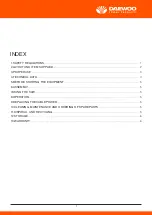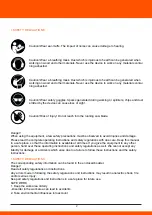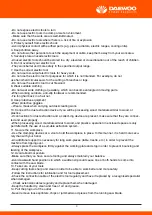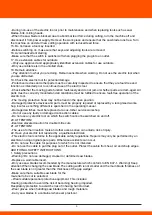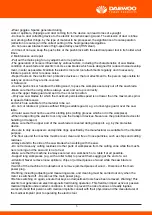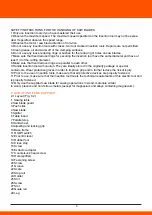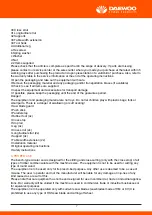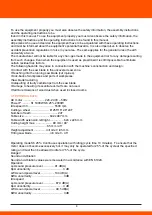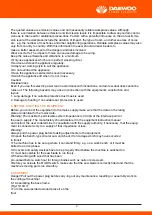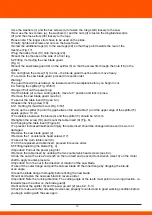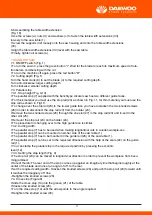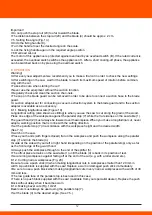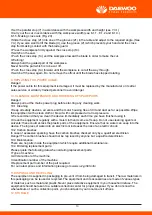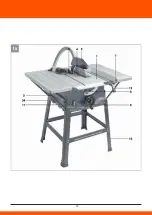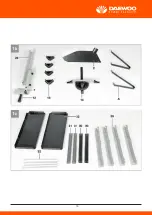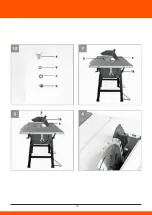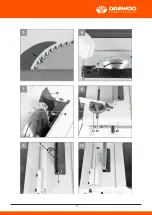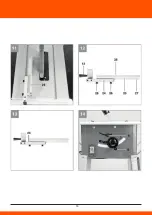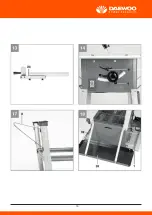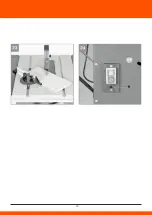
13
1. SAFETY REGULATIONS
Caution! Wear ear-muffs. The impact of noise can cause damage to hearing.
Caution! Wear a breathing mask. Dust which is injurious to health can be generated when
working on wood and other materials. Never use the device to work on any materials contai
ning
asbestos!
Caution! Wear a breathing mask. Dust which is injurious to health can be generated when
working on wood and other materials. Never use the device to work on any materials contai
ning
asbestos!
Caution! Wear safety goggles. Sparks generated during working or splinters, chips and dust
emitted by the device can cause loss of sight.
Caution! Risk of injury! Do not reach into the running saw blade.
Danger!
When using the equipment, a few safety precautions must be observed to avoid injuries and damage.
Please read the complete operating instructions and safety regulations with due care. Keep this manual
in a safe place, so that the information is available at all times. If you give the equipment to any other
person, hand over these operating instructions and safety regulations as well. We cannot accept any
liability for damage or accidents which arise due to a failure to follow these instructions and the safety
instructions.
1. SAFETY REGULATIONS
The corresponding safety information can be found in the enclosed booklet.
Danger!
Read all safety regulations and instructions.
Any errors made in following the safety regula-tions and instructions may result in anelectric shock, fi re
and/or serious injury.
Keep all safety regulations and instructions in a safe place for future use.
SAFE WORK
1. Keep the work area orderly
–Disorder in the work area can lead to accidents.
2. Take environmental influences into account
–Do not expose electric tools to rain
–Do not use electric tools in a damp or wet envi-ronment.
– Make sure that the work area is well-illuminated.
–Do not use electric tools where there is a risk of fire or explosion.
3. Protect yourself from electric shock
–Avoid physical contact with earthed parts (e.g. pipes, radiators, electric ranges, cooling units).
4. Keep children away
–Do not allow other persons to touch the equipment or cable, keep them away from your work area.
5. Securely store unused electric tools
–Unused electric tools should be stored in a dry, elevated or closed location out of the reach of children.
6. Do not overload your electric tool
–They work better and more safely in the specified output range.
7. Use the correct electric tool
–Do not use low-output electric tools for heavy work.
–Do not use the electric tool for purposes for which it is not intended. For example, do not
use hand-held circular saws for the cutting of branches or logs.
–Do not use the electric tool to cut firewood.
8. Wear suitable clothing
–Do not wear wide clothing or jewellery, which can become entangled in moving parts.
–When working outdoors, anti-slip footwear is recommended.
–Tie long hair back in a hair net.
9. Use protective equipment
–Wear protective goggles.
– Wear a mask when carrying out dust-creating work.
10. Connect the dust extraction device if you will be processing wood, materials similar to wood, or
plastics.
–If connections for dust extraction and a collect-ing device are present, make sure that they are connec-
ted and used properly.
–When processing wood, materials similar to wood, and plastics. operation in enclosed spaces is only
permitted with the use of a suit-able extraction system.
11. Secure the workpiece
–Use the clamping devices or a vice to hold the workpiece in place. In this manner, it is held more secu-
rely than with your hand.
–An additional support is necessary for long work-pieces (table, trestle, etc.) in order to prevent the
machine from tipping over.
–Always press the workpiece firmly against the working plate and stop in order to prevent bouncing and
twisting of the workpiece.
12. Avoid abnormal posture
–Make sure that you have secure footing and always maintain your balance.
–Avoid awkward hand positions in which a sudden slip could cause one or both hands to come into
contact with the saw blade.
13. Take care of your tools
–Keep cutting tools sharp and clean in order to be able to work better and more safely.
–Follow the instructions for lubrication and for tool replacement.
–Check the connection cable of the electric tool regularly and have it replaced by a recognised specialist
when damaged.
– Check extension cables regularly and replace them when damaged.
–Keep the handle dry, clean and free of oil and grease.
14. Pull the plug out of the outlet
–Never remove loose splinters, chips or jammed wood pieces from the running saw blade.
–During non-use of the electric tool or prior to maintenance and when replacing tools such as saw
blades, bits, milling heads.
–When the saw blade is blocked due to abnormal feed force during cutting, turn the machine off and
disconnect it from power supply. Remove the work piece and ensure that the saw blade runs free. Turn
the machine on and start new cutting operation with reduced feed force.
15. Do not leave a tool key inserted
–Before switching on, make sure that keys and adjusting tools are removed.
16. Avoid inadvertent starting
–Make sure that the switch is switched off when plugging the plug into an outlet.
17. Use extension cables for outdoors
– Only use approved and appropriately identified extension cables for use outdoors.
–Only use cable reels in the unrolled state.
18. Remain attentive
– Pay attention to what you are doing. Remain sensible when working. Do not use the electric tool when
you are distracted.
19. Check the electric tool for potential damage
–Protective devices and other parts must be care-fully inspected to ensure that they are fault-free and
function as intended prior to continued use of the electric tool.
–Check whether the moving parts function fault-lessly and do not jam or whether parts are dam-aged. All
parts must be correctly mounted and all conditions must be fulfilled to ensure fault-free operation of the
electric tool.
–The moving protective hood may not be fixed in the open position.
–Damaged protective devices and parts must be properly repaired or replaced by a recognised works-
hop, insofar as nothing different is speci-fied in the operating manual.
–Damaged switches must be replaced at a cus-tomer service workshop.
– Do not use any faulty or damaged connection cables.
–Do not use any electric tool on which the switch cannot be switched on and off.
20. ATTENTION!
–Exercise elevated caution for double mitre cuts.
21. ATTENTION!
–The use of other insertion tools and other acces-sories can entail a risk of injury.
22. Have your electric tool repaired by a qualified electrician
–This electric tool conforms to the applicable safety regulations. Repairs may only be performed by an
electrician using original spare parts. Otherwise accidents can occur.
23. Do not use the cable for purposes for which it is not intended
–Do not use the cable to pull the plug out of the outlet. Protect the cable from heat, oil and sharp edges.
ADDITIONAL SAFETY INSTRUCTIONS
1. Safety precautions
–Warning! Do not use damaged, cracked or deformed saw blades.
–Replace a worn table insert.
–Only use saw blades recommended by the manufacturer which conform to EN 847-1. Warning! Keep
attention When changing the saw blade.The cutting width is not smaller and the main blade thickness of
the saw blade is not greater than the thickness of the gap wedge!
–Make sure that a suitable saw blade for the
ma-terial to be cut is selected.
– Wear suitable personal protective equipment. This includes:
Hearing protection to avoid the risk of becoming hearing impaired,
Respiratory protection to avoid the risk of inhal-ing harmful dust,
–Wear gloves when handling saw blades and rough materials.
–Carry saw blades in a container whenever practi-cal.
–Wear goggles. Sparks generated during
work or splinters, chippings and dust coming from the device can lead to loss of eyesight.
–Connect a dust collecting device to the electric tool when sawing wood. The emission of dust is influe
ced, among other things, by the type of material to be processed, the significance of local separation
(collection or source) and the correct setting of the hood/guide plates/guides.
–Do not use saw blades made of high-speed alloy steel (HSS steel).
–In times of non-use keep the push stick or the push block with the electrical power tool in its holder at all
times.
2. Maintenance and repair
–Pull out the mains plug for any adjustment or repair tasks.
–The generation of noise is influenced by various factors, including the characteristics of saw blades,
condition of saw blade and electric tool. Use saw blades which were designed for reduced noise develop-
ment, insofar as possible. Maintain the electric tool and tool attachments regularly and if necessary,
initiate repairs in order to reduce noise.
–Report faults on the electric tool, protective devices or the tool attachment to the person responsible for
safety as soon as they are dis-covered.
3. Safe work
–Use the push stick or handle with sliding wood, to pass the workpiece securely out off the saw blade.
–Make sure that the riving knife is always used, and set up is correctly.
–Use the upper blade guard and set it to the cor-rect position.
– Only use saw blades for which the maximum permissible speed is not lower than the maxi-mum spind-
le speed of table saws
and which are suitable for the material to be cut.
–Do not cut rebates or grooves without fitting a suitable guard, e.g. a tunnel-type guard, over the saw
table.
–Circular saws must not be used for slotting jobs (cutting grooves which end in the workpiece).
–When transporting the electric tool, only use the transport devices. Never use the protective devices for
handling or transport.
–Make sure that the upper part of the saw blade is covered during transport, e.g. by the protective
device.
–Be sure to only use spacers and spindle rings specified by the manufacturer as suitable for the intended
purpose.
–The floor around the machine must be level, clean and free of loose particles, such as chips and cutting
residues.
–Always stand to the side of the saw blade when working with the saw.
–Do not remove any cutting residues or other parts of workpieces from the cutting zone while the machi-
ne is running and the saw unit is not at rest.
–Make sure that the machine is always secured on a workbench or a table if at all possible.
–Support long workpieces (e.g. with a roller table) to prevent them sagging at the end of a cut.
–Attention! Never remove loose splinters, chips or jammed pieces of wood while the saw blade is
running.
• Switch off the machine to troubleshoot or remo-ve jammed pieces of wood. - Disconnect the main
power plug -
• Refitting, including adjusting and measuring works, and cleaning must be carried out only when the
motor is switched off. - Disconnect the main power plug -
• Before switching on again, ensure that keys and adjustment tools have been removed. Warning! This
electric tool generates an electromag-netic field during operation. This field can impair active or passive
medical implants under certain conditions. In order to prevent the risk of serious or deadly injuries,
we recommend that persons with medical implants consult with their physician and the manufacturer of
the medical implant prior to operating the electric tool.
SAFETY INSTRUCTIONS FOR THE HANDLING OF SAW BLADES
1 Only use insertion tools if you have mastered their use.
2 Observe the maximum speed. The maximum speed specified on the insertion tool may not be excee-
ded. If specified, observe the speed range.
3 Observe the motor / saw blade direction of rota-tion.
4 Do not use any insertion tools with cracks. Sort out cracked insertion tools. Repairs are not permitted.
5 Clean grease, oil and water off of the clamping surfaces.
6 Do not use any loose reducing rings or bushes for the reducing of holes on saw blades.
7 Make sure that fixed reducer rings for securing the insertion tool have the same diameter and have at
least 1/3 of the cutting diameter.
8 Make sure that fixed reducer rings are parallel to each other.
9 Handle insertion tool with caution. They are ideally stored in the originally package or special
contain-ers. Wear protective gloves in order to improve grip and to further reduce the risk of injury.
10 Prior to the use of insertion tools, make sure that all protective devices are properly fastened.
11 Prior to use, make sure that the insertion tool meets the technical requirements of this electric tool and
is properly fastened.
12 Only use the supplied saw blade for sawing opera-tions in wood, materials similar
to wood, plastics and non-ferrous metals (except for magnesium and alloys containing magnesium).
2. LAYOUT AND ITEMS SUPPLIED
2.1 Layout (Fig. 1/2)
1. Sawing table
2 Saw blade guard
3 Push stick
4 Saw blade
5 Splitter
6 Table insert
7 Parallel stop
8 Hand wheel
9 Adjusting and locking grip
10 Base frame
11 On/Off switch
12 Eccentric lever
13 Rubber foot
14 Cross stop
15 Screw
16 Extractor adapter
17 Countersunk head screw
18 Hole (splitter)
19 Fastening screw
20 Screw
21 Groove
22 Scale
23 Stop rail
24 Holder
25 Slot
26 Screw
27 Slot
28 Guide rail
29 Leg
30 Cross strut
31 Longitudinal strut
32 Supports
33 Table width extension
34 Tool hook
A Additional leg
a Hex screw
b Spring washer
c Washer
d Nut
2.2 Items supplied
Please check that the article is complete as specifi ed in the scope of delivery. If parts are missing,
please contact our service center or the sales outlet where you made your purchase at the latest within 5
working days after purchasing the product and upon presentation of a valid bill of purchase. Also, refer to
the warranty table in the service information at the end of the operating instructions.
• Open the packaging and take out the equipment with care.
• Remove the packaging material and any packaging and/or transportation braces (if available).
• Check to see if all items are supplied.
• Inspect the equipment and accessories for transport damage.
• If possible, please keep the packaging until the end of the guarantee period.
Danger!
The equipment and packaging material are not toys. Do not let children play with plastic bags, foils or
small parts. There is a danger of swallowing or suff ocating!
• Saw blade guard
• Push stick
• Parallel stop
• Rubber foot (4x)
• Cross stop
• Stop rail
• Leg (4x)
• Cross strut (2x)
• Longitudinal strut (2x)
• Support (4x)
• Table width extension (2x)
• Installation material
• Original operating instructions
• Safety instructions
3. PROPER USE
The bench-type circular saw is designed for the slitting and cross-cutting (only with the cross stop) of all
types of timber commensurate with the machine‘s size. The equipment is not to be used for cutting any
type of round wood.
The equipment is to be used only for its prescri-bed purpose. Any other use is deemed to be a case of
misuse. The user / operator and not the manufacturer will be liable for any damage or inju-ries of any
kind caused as a result of this.
Please note that our equipment has not been de-signed for use in commercial, trade or industrial applica-
tions. Our warranty will be voided if the machine is used in commercial, trade or industrial businesses or
for equivalent purposes.
The equipment is to be operated only with suita-ble saw blades (saw blades made of HM or CV) It is
prohibited to use any type of HSS saw blade and cutting-off wheel.
To use the equipment properly you must also observe the safety information, the assembly instructions
and the operating instructions to be
found in this manual. To use the equipment properly you must also observe the safety information, the
assembly instructions and the operating instructions to be found in this manual.
All persons who use and service the equipment have to be acquainted with these operating instructions
and must be informed about the equipment‘s potential hazards. It is also imperati-ve to observe the
accident prevention regulations in force in your area. The same applies for the general rules of health
and safety at work.
The manufacturer will not be liable for any chan-ges made to the equipment nor for any damage resulting
from such changes. Even when the equipment is used as prescribed it is still impossi-ble to eliminate
certain residual risk factors.
The following hazards may arise in connection with the machine‘s construction and design:
• Contact with the saw blade in the uncovered saw zone.
• Reaching into the running saw blade (cut injuries).
• Kick-back of workpieces and parts of workpieces.
•Saw blade fracturing.
•Catapulting of faulty carbide tips from the saw blade.
• Damage to hearing if essential ear-muffs are not used.
•Harmful emissions of wood dust when used in closed rooms.
4. TECHNICAL DATA
AC motor ........................... 220- 240V ~ 50Hz
Power P .......... S1 1800W S6 25% 2000W
Idle speed n0 ................................. 5500 rpm
Cutting-o wheel ....................... Ø 255*16*2.8*24T
Number of teeth ................................. 24T
Table size ................................ 642x 487 mm
Table width extension, left/right ................. 624 x 226 mm
Cutting height max. ..................... 80 mm / 90°
.............................................. 65 mm / 45°
Height adjustment ............... infi nite 0 -85 mm
Tilting saw blade ...................... infi nite 0 - 45°
Operating mode S6 25%: Continuous operation with idling (cycle time 10 minutes). To ensure that the
motor does not become excessively hot, it may only be operated for 25% of the cycle at the specifi ed
rating and must then be allowed to idle for 75% of the cycle.
Danger!
Sound and vibration
Sound and vibration values were measured in accordance with EN 61029.
Operation
LpA sound pressure level ...............91 dB(A)
KpA uncertainty ........................................ 3 dB
LWA sound power level ................. 104 dB(A)
KWA uncertainty ....................................... 3 dB
Idle speed
LpA sound pressure level ............... 87,3 dB(A)
KpA uncertainty ........................................ 3 dB
LWA sound power level .................. 99,5 dB(A)
KWA uncertainty ....................................... 3 dB
The quoted values are emission values and not necessarily reliable workplace values. Although
there is a correlation between emission and im-mission levels it is impossible to draw any certain conclu-
sions as to the need for additional precau-tions. Factors with a potential infl uence on the ac-tual immis-
sion level at the workplace include the duration of impact, the type of room, and other sources of noise
etc., e.g. the number of machi-nes and other neighboring operations. Reliable workplace values may also
vary from country to country. With this information the user should at least be able to
make a better assessment of the dangers and risks involved.
Wear ear-muffs. The impact of noise can cause damage to hea-ring.
Keep the noise emissions and vibrations to a minimum.
• Only use appliances which are in perfect wor-king order.
• Service and clean the appliance regularly.
• Adapt your working style to suit the appliance.
• Do not overload the appliance.
• Have the appliance serviced whenever necessary.
• Switch the appliance off when it is not in use.
Caution!
Residual risks
Even if you use this electric power tool in accordance with instructions, certain resi-dual risks cannot be
rules out. The following hazards may arise in connection with the equipment’s construction and
layout:
1. Lung damage if no suitable protective dust mask is used.
2. Damage to hearing if no suitable ear protec-tion is used.
5. BEFORE STARTING THE EQUIPMENT
Before you connect the equipment to the mains supply make sure that the data on the rating
plate are identical to the mains data.
Warning! The maximum permissible system impedance is 0.340
Ω
at the interface point of
the user’s supply. The manufactory should declare it in the equipment instruction manual
and instruct the user to determine in consultation with the supply authority, if necessary, that the equip-
ment is connected only to a supply of that impedance or less.
Warning!
Always pull the power plug before making adjustments to the equipment.
• Unpack the bench-type circular saw and check it for damage which may have occurred
in transit.
• The machine has to be set up where it can stand firmly, e.g. on a work bench, or it must be
bolted to a strong base.
• All covers and safety devices have to be pro-perly fitted before the machine is switched on.
• It must be possible for the saw blade to run freely.
• When working with wood that has been
pro-cessed before, watch out for foreign bodies such as nails or screws etc.
• Before you actuate the On/Off switch, make sure that the saw blade is correctly fitted and that the
machine’s moving parts run smoothly.
6. ASSEMBLY
Danger! Pull out the power plug before carry-ing out any maintenance, resetting or assem-bly work on
the cutting-off machine!
6.1 Assembling the base frame
(Fig.15/16/17)
• Turn the saw upside down and place it on the
floor.
• Use the washers (c) and the hex screws (a) to fasten the 4 legs (29) loosely to the saw.
• Now use the hex screws (a), the washers (c) and the nuts (d) to fasten the longitudinal-struts
(31) and the cross-struts (30) loosely to the legs.
Please note: The longer struts have to be used on the sides.
• Finally, tighten all screws and nuts on the base frame.
• Screw the additional legs (A) to the rear legs (29) so that they point towards the rear of the
machine (Fig. 17).
• Plug the rubber feet (13) onto the legs (29).
• Mount the tool hooks on the side of a front leg.
6.2 Fitting / removing the saw blade guard
(Fig. 3)
• Mount the saw blade guard (2) on the splitter (5) so that the screw fits through the hole (18) in the
splitter.
• Do not tighten the screw (15) too far – the bla-de guard must be able to move freely.
• To remove the saw blade guard, proceed in reverse order.
Warning!
The guard hood (2) must always be lowered over the workpiece before you begin to cut.
6.3. Setting the splitter (Fig. 3/5/6/7)
• Danger! Pull out the power plug.
• Set the blade (4) to max. cutting depth, move to 0° position and lock in place.
• Remove the saw blade guard (see 6.2).
• Take out the table insert (6) (see 6.4).
• Slacken the fixing screw (19).
6.3.1. Setting for maximum cuts (Fig. 5/6/7)
• Push up the splitter (5) until the gap between the saw table (1) and the upper edge of the splitter (5)
equals approx. 10 cm.
• The distance between the blade (4) and the splitter (5) should be 3-5 mm.
• Retighten the screw (19) and mount the table insert (6) (Fig. 6).
6.4 Changing the table insert (Figure 6)
• To prevent increased likelihood of injury the table insert should be changed whenever it is worn or
damaged.
• Remove the saw blade guard (2).
• Remove the 1 countersunk head screws (17).
• Take out the worn table insert (6).
• To fit the replacement table insert, proceed in reverse order.
6.5 Fitting/replacing the blade (Fig. 4)
• Important! Pull out the power plug first.
• Remove the table insert by undoing the two countersunk head screws (see 6.4).
• Undo the nut with a size 24 wrench on the nut itself and a second fork wrench (size 10) on the motor
shaft to apply counter-pressure.
• Important! Turn the nut in the direction of rotation of the saw blade.
• Take off the outer flange and pull the old saw blade off the inner flange by dropping the bla-de
at an angle.
• Clean the blade flange thoroughly before fit-ting the new blade.
• Mount and fasten the new saw blade in reverse order.
• Important! Note the running direction. The cutting angle of the teeth must point in run-ning direction, i.e.
forwards (see the arrow on the blade guard).
• Refit and set the splitter (5) and the saw gu-ard (2) (see 6.2., 6.3.)
• Check to make sure that all safety devices are properly mounted and in good working condition before
you begin working with the saw again
6.6 Assembling the table width extension
(Fig. 18)
• Use the screws (a), nuts (d) and washers (c) to fasten the table width extensions (33)
loo-sely to the saw table (1).
• Screw the supports (32) loosely onto the saw housing and onto the table width extensions
(33).
• Align the table width extensions (33) level with the saw table.
• Finally, tighten all screws (a).
7. USING THE SAW
7.1. ON/OFF switch (Fig. 1)
• To turn the saw on, press the green button “I”. Wait for the blade to reach its maximum speed of rota-
tion before commencing with the cut.
• To turn the machine off again, press the red button “O”.
7.2. Cutting depth (Fig. 1)
Turn the hand crank (8) to set the blade (4) to the required cutting depth.
Turn anti-clockwise: larger cutting depth
Turn clockwise: smaller cutting depth
7.3. Parallel stop
7.3.1. Stop height (Fig. 9-13)
• The parallel stop (7) supplied with the benchtype circular saw has two different guide faces.
• For thick material you must use the stop rail (23) as shown in Fig. 11, for thin material you must use the
stop rail as shown in Fig.10.
• To change over the stop rail (23) to the lo-wer guide face you have to slacken the two knurled screws
(26) in order to disconnect the stop rail (23) from the holder (24).
• Remove the two knurled screws (26) through the one slot (27) in the stop rail (23) and in-sert in the
other slot (25).
• Remount the stop rail (23) on the holder (24).
• The procedure for changing over to the high guide face is similar.
7.3.2. Cutting width:
• The parallel stop (7) has to be used when making longitudinal cuts in wooden workpie-ces.
• The parallel stop (7) can be mounted on eit-her side of the saw table (1).
• The parallel stop (7) has to be mounted in the guide rail (28) of the saw table (1).
• The parallel stop (7) can be set to the requi-red dimension with the help of the scale (22) on the guide
rail (1).
• You can clamp the parallel stop in the requi-red position by pressing the eccentric
lever (12).
7.3.3. Setting the stop length (Fig. 9)
• The stop rail (23) can be moved in longitudi-nal direction in order to prevent the workpiece from beco-
ming jammed.
• Rule of thumb: The rear end of the stop co-mes up against an imaginary line that begins roughly at the
center of the blade and runs at an angle of 45° to the rear.
• Set the required cutting width - Slacken the knurled screws (26) and push the stop rail (23) forward until
it touches the imaginary 45° line.
- Retighten the knurled screws (26).
7.4. Cross stop (Figure 8)
• Slide the cross stop (14) into the groove (21) of the table.
• Slacken the knurled screw (20).
• Turn the cross stop (14) until the arrow points to the angle required.
• Retighten the knurled screw (20).
Important!
• Do not push the stop rail (23) too far toward the blade.
• The distance between the stop rail (23) and the blade (4) should be approx. 2 cm.
7.5. Setting the angle (Fig. 14)
• Undo the fixing handle (9).
• Turn the handle to set the desired angle on the scale.
• Lock the fixing handle again in the required angle position.
7.6 Overload cut-out
The motor of this appliance is protected against overload by an overload switch (B). If the rated current is
exceeded, the overload switch switches the appliance off . After a short cooling-off phase, the appliance
can be switched back on by pres-sing the overload switch.
8. OPERATION
Warning!
• After every new adjustment we recommend you to make a trial cut in order to check the new settings.
• After switching on the saw, wait for the blade to reach its maximum speed of rotation before commen-
cing with the cut.
• Take extra care when starting the cut!
• Never use the equipment without the suction function.
• Regularly check and clean the suction chan-nels.
• The cap on the blade guard can be removed in order to be able to connect a suction hose to the blade
guard.
• A suction adapter set for connecting a vacuum extraction system to the blade guard and to the suction
adapter is available as an accessory.
8.1.1 Making longitudinal cuts (Figure 19)
Longitudinal cutting (also known as slitting) is when you use the saw to cut along the grain of the wood.
Press one edge of the workpiece against the parallel stop (7) while the fl at side lies on the saw table (1).
The guard hood (2) must always be lowered over theworkpiece.When you make a longitudinal cut, never
adopt a working position that is in line with the cutting direction.
• Set the parallel stop (7) in accordance with the workpiece height and the desired width.
(See 7.3.)
• Switch on the saw.
• Place your hands (with fingers closed) flat on the workpiece and push the workpiece along the parallel
stop (7) and into the blade (4).
• Guide at the side with your left or right hand (depending on the position of the parallel stop) only as far
as the front edge of the gu-ard hood.
• Always push the workpiece through to the end of the splitter (5).
• The offcut piece remains on the saw table (1) until the blade (4) is back in its position of rest.
• Secure long workpieces against falling off at the end of the cut (e.g. with a roller stand etc.).
8.1.2. Cutting narrow workpieces (Fig. 20)
Be sure to use a push stick (3) when making longitudinal cuts in workpieces smaller than 120 mm in
width. A push block is supplied with the saw! Replace a worn or damaged push stick im-mediately.
• Be sure to use a push block when making longitudinal cuts in very narrow workpieces with a width of 30
mm and less.
• The low guide face of the parallel stop is best used in this case.
• There is no push block supplied with the saw! (Available from your specialist dealer). Replace the push
block without delay when it becomes worn.
8.1.4. Making bevel cuts (Fig. 14/22)
Bevel cuts must always be used using the parallel stop (7).
• Set the blade (4) to the desired angle. (See 7.5.)
• Set the parallel stop (7) in accordance with the workpiece width and height (see 7.3.1)
• Carry out the cut in accordance with the work-piece width (see 8.1.1., 8.1.2 and 8.1.3.)
8.1.5. Making cross cuts (Fig. 23)
• Slide the cross stop (21) into one of the grooves (21) in the table and adjust to the required angle. (See
7.4.) If you also want to tilt the blade (4), use the groove (21) which prevents your hand and the cross
stop frommaking contact with the blade guard.
• Press the workpiece firmly against the cross stop (14).
• Switch on the saw.
• Push the cross stop (14) and the workpiece toward the blade in order to make the cut.
• Warning!
Always hold the guided part of the workpiece.
Never hold the part which is to be cut off.
• Push the cross stop (14) forward until the workpiece is cut all the way through.
• Switch off the saw again. Do not remove the offcut until the blade has stopped rotating.
9. REPLACING THE POWER CABLE
Danger!
If the power cable for this equipment is damaged, it must be replaced by the manufacturer or its after
sales service or similarly trained personnel to avoid danger.
10. CLEANING, MAINTENANCE AND ORDERING OF SPARE PARTS
Danger!
Always pull out the mains power plug before star-ting any cleaning work.
10.1 Cleaning
• Keep all safety devices, air vents and the motor housing free of dirt and dust as far as possible. Wipe
the equipment with a clean cloth or blow it with compressed air at low pressure.
• We recommend that you clean the device immediately each time you have finished using it.
• Clean the equipment regularly with a moist cloth and some soft soap. Do not use cleaning agents or
solvents; these could at-tack the plastic parts of the equipment. Ensu-re that no water can seep into the
device. The ingress of water into an electric tool increases the risk of an electric shock.
10.2 Carbon brushes
In case of excessive sparking, have the carbon brushes checked only by a qualifi ed electrician.
Danger! The carbon brushes should not be rep laced by anyone but a qualifi ed electrician.
10.3 Maintenance
There are no parts inside the equipment which require additional maintenance.
10.4 Ordering replacement parts:
Please quote the following data when ordering replacement parts:
• Type of machine
• Article number of the machine
• Identification number of the machine
• Replacement part number of the part required
For our latest prices and information please go to
www.isc-gmbh.info
11. DISPOSAL AND RECYCLING
The equipment is supplied in packaging to pre-vent it from being damaged in transit. The raw materials in
this packaging can be reused or recycled. The equipment and its accessories are made of various types
of material, such as metal and plastic. Never place defective equipment in your household refuse. The
equipment should be taken to a suitable collection center for proper disposal. If you do not know the
whereabouts of such a collection point, you should ask in your local council offi ces.
12. STORAGE


